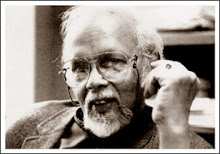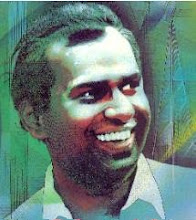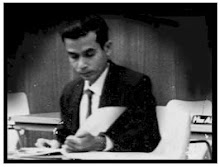Author: Randima Attygalle Source: Nation Date: 30/08/2009
Premayen mana ranjithawe- nanditha we
Pushpayen wana sundara we- lankrutha we
Aalayen weli sedi me latha- alayen weli sedi me latha
Mandapayen chandapatha kanditha we hiru rajinduge….
(Maname)
 Gale lena bindala, len dora erala
Gale lena bindala, len dora erala
Sinhaba… sinhaba  …
…
Gosin sema thena- gosin hema dena
Nethe kisiwek
Mama denagathimi, mama seka kalemi (Sinhabahu)
Professor Ediriweera Sarachchandra’s quest for an authentically ‘local idiom’ gave birth to theatrical marvels which  have stood the test of time. A literary genius who revived Sinhala literature and whose footprints across the local stage have guided many along the paths of wisdom, Prof. Sarachchandra’s legacy is astounding. The Nation salutes this legendary sage whose 13th death anniversary fell on August 16
have stood the test of time. A literary genius who revived Sinhala literature and whose footprints across the local stage have guided many along the paths of wisdom, Prof. Sarachchandra’s legacy is astounding. The Nation salutes this legendary sage whose 13th death anniversary fell on August 16
The sheer lyrical delight interwoven with the mastery of theatrical craft is the genre of late Prof. Ediriweera Sarachchandra. A legendary dramatist, poet, novelist, literary critic and an unrivalled genius of a scholar, Prof. Sarachchandra turned a distinct chapter in the annals of local Sinhala drama. The late sage conceived an unmistakable local idiom of Sinhala drama, nourished by naadagam (folk drama tradition), Jaathakas and Sanskrit tradition. Fruits of such theatrical labours were phenomenal; Maname, Sinhabahu, Pematho jayathi soko, Wessanthara, Mahasara, Loma Hansa being few holding testimony to it. Whilst invigorating the Sinhala drama culture with masterpieces which have stood the test of time, Prof. Sarachchandra had enthralled many a lover of Sinhala drama, inspiring generations of dramatists.
November 3, 1956 marked a decisive era in the history of modern Sinhala drama, when Maname went on the boards at the Lionel Wendt Theatre. Inspired by Chulla Dhanuddara Jathakaya and drawing the critic acclaim like no other theatre attempt, Maname laid the ‘dais’ for future Sinhala drama.
Sources of inspiration
Celebrated scholar and literary critic Prof. Sucharitha Gamlath, recalling ‘Peradeniya times’ with guru Sarachchandra said, “It was in the late ’50s I came to know Prof. Sarachchandra, in the aftermath of his celebrated Maname. This was the time Sinhabahu was being done, which I believe to be the most fruitful era of Prof. Sarachchandra’s theatrical career. It was the era during which he gained foreign exposure, carried out extensive research and returned to the country. This wealth of experience reaped from contemporary global trends, both eastern and western, reflected in his work.”
Prof. Sarachchandra’s exploitation of both naadagam and Sanskrit tradition of drama is viewed by Prof. Gamlath as a ‘supplementary’ tool of theatre, complementing each other and justifying the end product. “The sources he exploited to nourish Sinhala drama were extensive. From naadagam style, Indian classical style to Western trends, Prof. Sarachchandra derived immense inspiration, out of which was borne an authentic genre of local drama,” he elaborated further.
Prof. Sarachchandra’s contribution to Sinhala literature and kaviya was exceptional. Dr Gunadasa Amarasekera had once identified him as the ‘best Sri Lankan poet ever’, a stance held by numerous other artistes and critics. “The secret behind the success of Prof. Sarachchandra’s poetic faculty is his ability to draw a perfect classical Sinhala idiom. Juxtaposing deep human emotions with simplicity, Prof. Sarachchandra created very poignant, dramatic lyrics parallel to none,” explained Prof. Gamlath, adding that work such as Sahithya Vidyawa, Sinhala Nawakatha Ithihasaya saha Wicharaya, Sinhala Gemi Natakaya are acclaimed as some of the finest Sinhala literary work to date.
In search of a local idiom
‘Modern epoch of Sinhala drama’ is essentially the definition of Prof. Sarachchandra’s theatre craft, in the eyes of eminent artiste and dramatist Jayalath Manoratne. Prof. Sarachchandra is ‘an indispensable shadow’ in the lives of many celebrated artistes today; Manoratne being no exception. “The strides Prof. Sarachchandra took in the Sinhala theatre world, in search of an indigenous idiom, commencing with his landmark creation Maname, were nothing but footsteps for future generations to follow. Acclaimed dramatist late Dayananda Gunawardene is one such classic example of his influence, followed by many more,” explained Manoratne, who first came under the tutelage of Prof. Sarachchandra when he was Prof. of Sinhala at the University of Peradeniya. Having played in the third productions of Maname and Sinhabahu, Manoratne’s breakthrough came in Pematho jayathi soko, where he played the lead role. “This was a turning point in my acting career, followed by Prof. Sarachchandra’s later productions, including Wessanthara, Kada Walalalu, Elowa gihin melowa aawa and Mahasara, in which I was privileged to have portrayed the main role,” added Manoratne.
A mentor of inspiration
‘Wit, forthrightness and simplicity’ are the cornerstones which made the mettle of this legendary artiste, according to Buddhadasa Galappatty, whose acquaintance with Prof. Sarachchandra dates back to 1969, when he became the stage manager for the reproduction of Maname. “I was introduced to Prof. Sarachchandra by my guru Prof. Tissa Kariyawasam, when Maname was to be reproduced. I was privileged to have worked with most of the ‘maiden cast’ of Maname, including Trilicia Gunawardene, Ben Sirimanna, Edmund Wijesinghe, Shaman Wijesinghe and Lionel Fernando in 1969. Padmakumara Ediriweera and Wimaladharma Diyasena were the chief makeup artistes of Prof. Sarachchandra’s plays at the time, and I was fortunate to have come under the guidance of them, whose expertise inspired me,” recalled Galappatty, who bid adieu to his days as a stage manager and took up the creative and the demanding task of a makeup artiste. Since then, Galappatty has been adding his creative flavour to all productions of Prof. Sarachchandra. “The fact that I was going to be a huge part of legendary Prof. Sarachchandra’s labours, unnerved me at first,” recalled Galappatty with a smile.
Key to Prof. Sarachchandra’s theatrical success is also attributed to his discipline and sense of time, according to Galappatty. “He was a strong advocate of time and discipline, demanding absolute focus on the task ahead, that was unconsciously drilled into everybody closely associated with him,” he explained.
Stylized drama was the forte of Prof. Sarachchandra, which he exploited in depth, his lyrical faculties enriching it. “His gift for lyrics was simply exceptional that, if one says he’s the best Sinhala poet we ever had, I think it’s no exaggeration,” said Galappatty further.
Best theatre researcher ever
Revered traditions of drama, deeply rooted, were brought to the modern stage by Prof. Sarachchandra with a seemingly ease, blending east with the west and giving birth to what can be correctly patented as ‘authentically Sri Lankan’. “Prof. Sarachchandra is the best theatre researcher Sri Lanka ever had. Blending naadagam, sokari, Tamil dance and song tradition, Kabuki and the western modes, he developed a drama tradition which we can call uniquely Sri Lankan,” explained eminent dramatist Dharmasiri Bandaranayake. According to Bandaranayake, the in-depth and tireless research of Prof. Sarachchandra, undoubtedly strengthened and shaped the faculties of his ‘golayas’. “Dayananda Gunawardene, Sugathapala de Silva are best examples who took his legacy forward with their individual style,” said Bandaranayake, adding that, the time has dawned upon Sri Lankan theatre to look back, reminisce and may be even revert to that ‘rich research era’ of drama.
Human life and its pathos were the ‘life’ of all Prof. Sarachchandra’s work, believes Bandaranayake. “Whether it was Maname, Sinhabahu, Wessanthara, Pematho jayathi soko or his celebrated literary work, Malawunge Avurudu da or Malagiya eththo, it is essentially human ethos, Prof. Sarachchandra brought to life,” final words of Bandaranayake seemed to transpire the wisdom embedded in complexity and intricacy of the late sage’s evergreen literary marvels…
(Photo credit: The Nation extends its sincere thanks to Buddhadasa Galappatty for providing access to photographs of D.B. Suranimala and late D. Galappatty)




































It is interesting to note that Pro:Sarachchandra was able to create a dramatic genre fusing his individual artistic compositions and the Sri Lankan folk theatrical forms. However it is also sad to inform that he did not try to preserve the late productions through video.When Henri Jayasena had introduced this method. Sarachchandra had refused his invitation thinking it would hamper his financial gains through drama.Today such early productions are rare except for a few like Hunuwataya Katawa, Kalani Palama due to the futuristic approach of late Henri Jayasena.
ReplyDeleteI think in Sri Lankan we need to digitalize the dramas shown at the state drama festivals at least so that the future generations could have an idea how such productions were done.Infact now videoing a drama is not a huge task that could be done even using a hand cam.